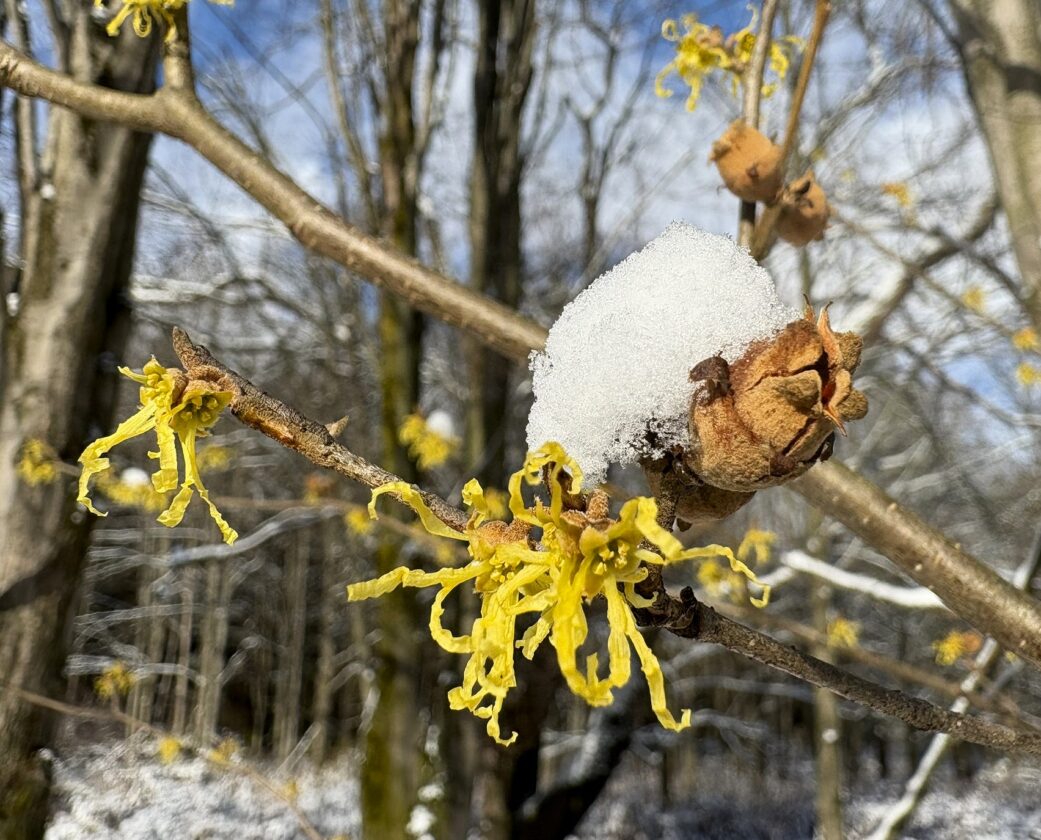Witch Hazel comes to life in November

Photo by Katie Finch Witch Hazel blooms and seed pods blanketed with the first snow of the season in November.
- Photo by Katie Finch Witch Hazel blooms and seed pods blanketed with the first snow of the season in November.
- Photo by George Lezenby Witch Hazel flowers give the late fall woods a pop of color.
- Photo by Jennifer Schlick The wavy-edged leaves of Witch Hazel provide good spring and summer cover in the forest understory.
Flowers are not what one thinks about in November. But American Witch Hazel takes center stage October through December. The delicate, yellow, spider-looking blooms stand alone as the last of the season. Even their leaves have dropped before the flowers bloom.
Whenever I point out Witch Hazel shrubs in our outdoor adventures, my husband responds, with mock curiosity “Which hazel?” While it is a groan-worthy dad joke, it is actually a good question. There are five species of Witch Hazel and several cultivars. American or Common Witch Hazel (Hamamelis virginiana) is native to our region and across the east coast.
The branches of this multi-stemmed shrub open wide and vase-like in the semi-wet, semi-shady understory and edges of forests. Averaging 10 -15 feet tall, it can also be incorporated into landscaping. Some gardeners even prune it to look like a small tree. The flowers provide food for late foraging bees and flies. The wavy-edged leaves provide good spring and summer greenery, and it is the host plant for Witch Hazel Dagger Moth caterpillars.
Witch Hazel may be more familiar as a product in the medicine cabinet than a native plant. The twigs and bark from the Witch Hazel plant are distilled to make the topical skin astringent of the same name. The forked branches are also used as dowsing rods, a divination method for finding water or minerals underground.

Photo by George Lezenby Witch Hazel flowers give the late fall woods a pop of color.
Along with the late fall blooming flowers, one of the most amazing things about Witch Hazel are the seeds. In late summer, before the flowers bloom, the seeds become ripe and ready to disperse. There are a variety of ways seeds can move away from their parent plant to colonize new areas. Wind, water, sticking to animal fur, or traveling through animal bellies are all methods to spread seeds. But Witch Hazel seeds have figured out something more bizarre. They explode.
As their pods dry out, pressure builds until the seeds shoot out of the pod at about 20 miles per hour. Scientists at Duke University were able to capture this ballistic seed dispersal on a camera recording at 100,000 frames per second. For comparison, the slow motion on most cell phone cameras is commonly 240 frames per second.
Witch Hazel isn’t the only plant that has exploding seeds. Wood Sorrel, violets, Jewelweed, Hairy Bittercress, and Impatiens are a few of the plants that also developed this forceful ejection of seeds. Nature has figured out many ways to survive.
But how did we figure this out? How did humans learn that seeds explode? So much of what we know about the world is through observation. So, I posit that someone at some point had to be in the woods, still and quiet, at the very moment a Witch Hazel seed pod exploded. I like to think I spend a lot of time outside. But when I think about being present for the exact moment such as this, I become aware of how much I still miss.
For those who collect and grow plants from seeds, the advice for collecting Witch Hazel seeds is to collect them in late summer or early fall before they are completely dried out and open on their own. Then bring them inside and put them in a paper bag. This also sounds like great advice for curious minds who want to learn more about how our world works. Keeping the seed inside and waiting for the seed pod to dry may allow for a better chance of hearing them explode. If you are curious, that is.

Photo by Jennifer Schlick The wavy-edged leaves of Witch Hazel provide good spring and summer cover in the forest understory.
The natural world is full of questions, those we have answered and those yet to be answered. It is full of wonder and diversity. Witch Hazel is just one of many valuable and interesting native plants that brings a pop of color and of seeds when you least expect it.
Audubon Community Nature Center builds and nurtures connections between people and nature. ACNC is located just east of Route 62 between Warren and Jamestown. The trails are open from dawn to dusk and birds of prey can be viewed anytime the trails are open. The Nature Center is open from 10 a.m. until 4:30 p.m. daily except Sunday when it opens at 1 p.m. More information can be found online at auduboncnc.org or by calling (716) 569-2345.





